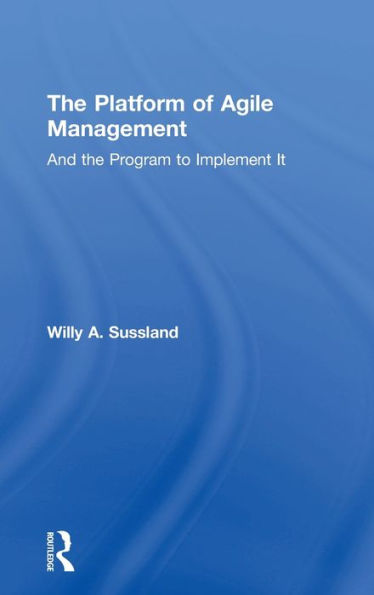
The Platform of Agile Management: And the Program to Implement It
224
The Platform of Agile Management: And the Program to Implement It
224Hardcover
-
PICK UP IN STORECheck Availability at Nearby Stores
Available within 2 business hours
Related collections and offers
Overview
Management cannot innovate itself, it needs people with the right motivation and with the right mind-set. However, stuck in the old system, people can only keep working in the old ways and means. Thus, the leadership must start by replacing a traditional system with a new and agile one, which will unbridle entrepreneurship.
The Platform of Agile Management and the Program to Implement It combines 3 principles that help to innovate thinking, 3 paradigms to innovate behaviours, and 3 practices to innovate and to accelerate actions. The proposed platform is comprehensive, connective, and congenial. It is implemented with an agile program that combines top down push by the leadership with the bottom up pulled by the people. Then, the proposed platform will generate continuous improvements and innovations of the performance drivers.

Product Details
| ISBN-13: | 9781138289826 |
|---|---|
| Publisher: | Taylor & Francis |
| Publication date: | 09/13/2017 |
| Pages: | 224 |
| Product dimensions: | 6.12(w) x 9.19(h) x (d) |
About the Author
Dr. Willy A. Sussland is the author or co-author of well over a half a dozen business books as well as of a string of papers that build on his experiences consulting with the senior management of private and public enterprises; in ascending international positions with multinational corporations based in Europe, in the USA, and in Latin America; lecturing strategic management to post-graduate MBAs at the Swiss Federal Institute of Technology Lausanne, and at the University of Geneva.
Table of Contents
Introduction Part One: The Principles of The Platform of Agile Management 1. The Why, The Who, and The How Opening remarks 1.1. The why of agile management 1.2. The who of agile management 1.3. The how of agile management Closing remarks 2. The 3 Tutors Of Thought and Systemic, Stimulating, and Systematic Thinking Opening remarks 2.1. The systemic and strategic principles 2.2. The stimulating and synergizing principles 2.3. The systematic and swiftness principles 3. The Triple "A" of Agile Management Opening Remarks 3.1. The basics of agile management Closing remarks Part Two: The Paradigms of The Platform of Agile Management 4. The 4 Behavioral Drivers 5. The Business Value and The 5 Corporate Capitals Opening remarks 5.1. The tangible and the intangible resources 5.2. The 5 corporate capitals 5.3. The capital-components Closing remarks 6. The Organizational Capital and its 5 Capital Components Opening remarks 6.1. The organizational capital 6.2. The strategy fundamentals 6.3. The systems of management 6.4. The style of the leadership 6.5. The structures of the organization 6.6. The shared critical capabilities Closing remarks 7. The Talent Capital Opening remarks 7.1. The war for talents 7.2. I know talent when I see it 7.3. The talent capital and the self-manage teams 7.4. The management of the human resources 7.5. The administration of the human resources Closing remarks 8. The Market Capital Opening remarks 8.1. The product capital 8.2. The brand capital 8.3. The customer-capital Closing remarks 9. The Life- and Time-Cycles, and the Financial Capital Opening remarks 9.1. The life-cycles and the time-cycles 9.2. The time-cycles 9.3. The financial capital 10. The 5 Value-Chains Opening remarks 10.1. The strategic approach to the value-chains 10.2. The structures of the 5 value-chains 10.3. The organizational approach to the 5 value-chains 10.4. The scrum Closing remarks Part Three: The Practices of The Platform of Agile Management 11. The Strategic Planning Opening remarks 11.1. The traditional strategic planning 11.2. The why of strategic planning 11.3. The who of strategic planning 11.4. The how of strategic planning Closing remarks 12. The Agile Development and Deployment of Strategies Opening remarks 12.1. Hoshin Planning 12.2. The Model of the Two Rings 12.3. The 4 steering processes on the outer ring Closing remarks 13. The Model of the Two Rings and the Agile Modus Operandi Opening remarks 13.1. The agile modus operandi 13.2. The IT-platform Closing remarks 14. The Reviews–Evaluations–Recognition System Opening remarks 14.1. The reviews 14.2. The performance evaluation system 14.3. The business-value and the return on total resources 14.4. The management scoreboard 14.5. The recognitions and the rewards 14.6. The strategic agility and the operational agility Closing remarks Part Four: The Program of Management Innovation 15. Programs of Management Innovation 16. The Decision-Making 16.1. The why 16.2. The who 16.3. The how 17. The Preparations and Building Support 17.1. The preparation of the launch 17.2. The program of the introductory seminars 18. The Launch of the Program and the Improvements 19. The Reviews, The Extension, and the Renewal of the Program Part Five: Leading Thoughts 20. The 5 Avenues for Management Innovation 20.1. Measuring and managing the business value 20.2. Culture 20.3. The stakeholders 20.4. The innovation of management innovation 20.5. The tutors of thought Appendix 1: Maps
